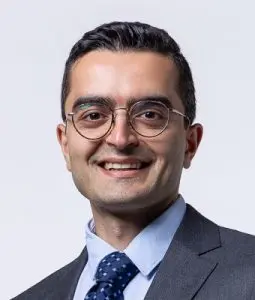Recovery of Vision in Open Globe Injury Patients with Initial No Light Perception Vision
September 2024

Hasenin Al-khersan M.D.
Retina Consultants of Texas
Houston, TX
Sherif NA, Hoyek S, Wai K, Makhoul KG, Bitar R, Tieger M, Lorch AC, Patel NA, Armstrong GW. Recovery of Vision in Open Globe Injury Patients with Initial No Light Perception Vision. Ophthalmol Retina. 2024 Jul;8(7):617-623.
Open-globe injuries (OGI) consist of full thickness wounds in the eye wall, most often caused by trauma. Presenting visual acuity has consistently been shown to be associated with final visual outcomes. Nevertheless, some patients with poor presenting vision, including no light perception (NLP), may still recover some vision.
Variable approaches exist to the management of OGIs with NLP vision at presentation. Historically, patients may have been more likely to undergo primary enucleation. However, more recently, practice patterns have shifted toward initial surgical repair. A study by Sherif et al in Ophthalmology Retina sought to specifically characterize outcomes in patients presenting with OGIs and initial NLP vision.
The retrospective study analyzed patients >10 years of age at the Massachusetts Eye and Ear Infirmary from January 1999 to March 2022. Patients with OGIs and NLP vision at presentation were required to have at least 1 week of follow-up. Collected information included presenting visual acuity, mechanism and zone of injury, as well as final visual acuity outcome.
In total, 147 eyes of 145 (67%) patients were included in the analysis. Of these, 17% regained better than NLP vision at their most recent follow-up. Interestingly, factors including mechanism of injury, presence of APD, Zone III injuries, IOFB, RD, and repair within 24 hours were not found to significantly correlate with final vision, demonstrating the difficulty in predicting visual acuity outcomes in this subset of eyes. Further studies are needed to validate these results as they contradict prior investigations that have, for example, noted a correlation between Zone III injuries and worse visual prognosis.
The largest limitations of the study are its retrospective nature and long study interval. Many surgical advances have occurred in ophthalmic trauma over the 22-year study period evaluated. A subanalysis of visual acuity outcomes by decade would have been helpful in evaluating whether the evolution of surgical techniques impacted results.
These findings, nevertheless, suggest that primary surgical repair of OGIs presenting with NLP vision should be performed (when anatomically possible) due to the difficulty in predicting final outcomes in these eyes.
